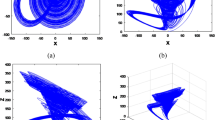Abstract
Recently, a color image encryption scheme based on the Sine-Sine chaotic system has been proposed by Wang et al. (Signal Processing 144:444–452, 2018). In their scheme, a private parameter E is defined based on global plain information in hope of resisting the chosen-plaintext attack. However, we find that the private parameter is dependent purely on average intensity of a plain image, thereby leaving an open door for cryptanalysis. In this paper, we propose a collision-based inference algorithm to effectively break Wang’s image cipher. Then, in order to enhance the security, we develop a hash-based cryptosystem under the permutation-and-diffusion architecture. We conduct experiments and perform extensive comparative studies.The qualitative and quantitative results demonstrate the effectiveness of the collision-based inference algorithm, and the superiority of the proposed image cipher especially in terms of plaintext sensitivity.









Similar content being viewed by others
Notes
In Wang’s scheme [19], the private parameter E was considered to be precise to 14 decimal places in their experimental section.
As mentioned before, αj lies in the interval [0,L − 1]. Therefore, we do not need to consider the case that αj = L.
Recall that L stands for the number of 8-bit pixels. In this simulation, L equals 256 × 256 × 3 = 196608 (or 65535 for grayscale images). We have L2 = 3.8655 × 1010 (or 4.2948 × 109 for grayscale images).
The key space of Wang’s image cipher [19] is 2128 ≈ 3.4028 × 1038.
In Pak’s scheme, NPCR and UACI were used to evaluate the key sensitivity. The examination of the plaintext sensitivity was absent in their work.
References
Chen JX, Zhu ZL, Fu C, Yu H, Zhang YS (2015) Reusing the permutation matrix dynamically for efficient image cryptographic algorithm. Signal Process 111:294–307
Chen JX, Zhu ZL, Fu C, Zhang LB, Zhang YS (2015) An efficient image encryption scheme using lookup table-based confusion and diffusion. Nonlinear Dynam 81(3):1151–1166
Diab H, El-semary AM (2018) Cryptanalysis and improvement of the image cryptosystem reusing permutation matrix dynamically. Signal Process 148:172–192
Diaconu AV (2016) Circular inter-intra pixels bit-level permutation and chaos-based image encryption. Inform Sci 355-356:314–327
Fan HJ, Li M (2017) Cryptanalysis and improvement of chaos-based image encryption scheme with circular inter-intra-pixels bit-level permutation. Math Problems Eng 8124912:11
Fan HJ, Li M, Liu D, Zhang E (2018) Cryptanalysis of a colour image encryption using chaotic APFM nonlinear adaptive filter. Signal Process 143:28–41
Fridrich J (1998) Symmetric ciphers based on two-dimensional chaotic maps. Int J Bifurcat Chaos 8(6):1259–1284
Geetha S, Punithavathi P, Infanteena AM, Sindhu SSS (2018) A literature review on image encryption techniques. Int J Inform Secur Priv 12(3):42–83
Hsiao HI, Lee JH (2015) Color image encryption using chaotic nonlinear adaptive filter. Signal Process 117:281–309
Hu GQ, Xiao D, Wang Y, Li XY (2017) Cryptanalysis of a chaotic image cipher using Latin square-based confusion and diffusion. Nonlinear Dynam 88(2):1305–1316
Laiphrakpam DS, Khumanthem MS (2017) Cryptanalysis of symmetric key image encryption using chaotic Rossler system. Optik 135:200–209
Lin ZS, Yu SM, Lü JH, Cai ST, Chen GR (2015) Design and ARM-embedded implementation of a chaotic map-based real-time secure video communication system. IEEE Trans Circ Syst Video Technol 25 (7):1203–1216
Liu Y, Tong XJ, Ma J (2016) Image encryption algorithm based on hyper-chaotic system and dynamic S-box. Multimed Tools Appli 75(13):7739–7759
Mandal MK, Kar M, Singh SK, Barnwal VK (2014) Symmetric key image encryption using chaotic Rossler system. Secur Commun Netw 7 (14):2145–2152
Norouzi B, Mirzakuchaki S (2017) Breaking a novel image encryption scheme based on an improper fractional order chaotic system. Multimed Tools Appli 76 (2):1817–1826
Özkaynak F (2018) Brief review on application of nonlinear dynamics in image encryption. Nonlin Dynam 92(2):305–313
Pak C, Huang LL (2017) A new color image encryption using combination of the 1D chaotic map. Signal Process 138:129–137
Solak E, Çokal C, Yildiz OT (2010) Cpyptanalysis of Fridrich’s chaotic image encryption. Int J Bifurcat Chaos 20(5):1405–1413
Wang H, Xiao D, Chen X, Huang HY (2018) Cryptanalysis and enhancements of image encryption using combination of the 1D chaotic map. Signal Process 144:444–452
Wu JH, Liao XF, Yang B (2018) Cryptanalysis and enhancements of image encryption based on three-dimensional bit matrix permutation. Signal Process 142:292–300
Xie EY, Li CQ, Yu SM, Lü JH (2017) On the cryptanalysis of Fridrich’s chaotic image encryption scheme. Signal Process 132:150–154
Zhang W, Yu H, Zhao YL, Zhu ZL (2016) Image encryption based on three-dimensional bit matrix permutation. Signal Process 118:36–50
Zhang XP, Nie WG, Ma YL, Tian QQ (2017) Cryptanalysis and improvement of an image encryption algorithm based on hyper-chaotic system and dynamic S-box. Multimed Tools Appli 76(14):15641–15659
Zhang YQ, Wang XY (2014) A symmetric image encryption algorithm based on mixed linear-nonlinear coupled map lattice. Inform Sci 273:329–351
Zhang YQ, Wang XY (2015) A new image encryption algorithm based on non-adjacent coupled map lattices. Appli Soft Comput 26:10–20
Zhao JF, Wang SY, Chang YX, Li XF (2015) A novel image encryption scheme based on an improper fractional-order chaotic system. Nonlinear Dynam 80(4):1721–1729
Acknowledgments
This work was supported in part by the National Key Research and Development Program of China (2019YFC1521300), the National Natural Science Foundation of China (61806171), the Program for the Fundamental Research of the Shanghai Committee of Science and Technology (15JC1400600), and the Fundamental Research Funds of the Central Universities (16D110412,17D110408).
Author information
Authors and Affiliations
Corresponding author
Additional information
Publisher’s note
Springer Nature remains neutral with regard to jurisdictional claims in published maps and institutional affiliations.
Rights and permissions
About this article
Cite this article
Huang, R., Liao, X., Dong, A. et al. Cryptanalysis and security enhancement for a chaos-based color image encryption algorithm. Multimed Tools Appl 79, 27483–27509 (2020). https://doi.org/10.1007/s11042-020-09163-3
Received:
Revised:
Accepted:
Published:
Issue Date:
DOI: https://doi.org/10.1007/s11042-020-09163-3




